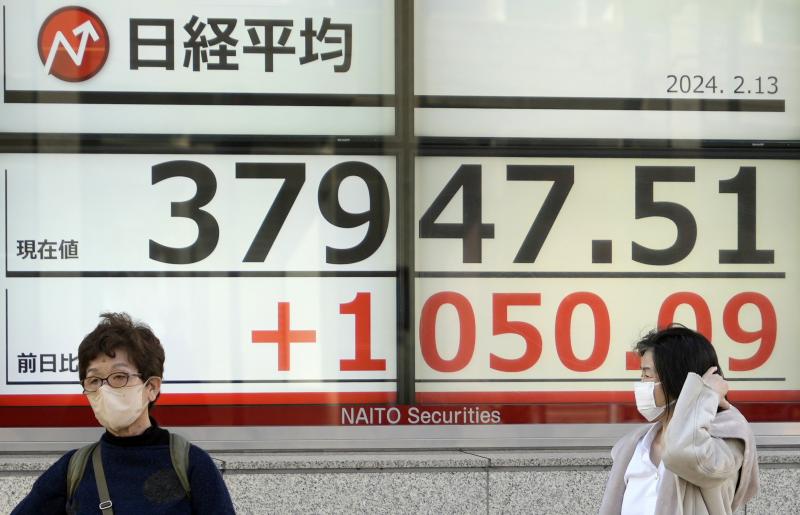Japanese shares touched a 34-year peak yesterday, as foreign investors continued to flock to the market, attracted by low valuations, changes in corporate governance and a weak yen that has made Japanese companies' products more attractive globally.
The Nikkei 225 index climbed 2.89 percent to close at 37,963.97, hitting its highest since January 1990, after briefly breaching 38,000 points, while the broader TOPIX rose 2.12 percent. The Nikkei has gained more than 13 percent so far this year, after rising 28 percent last year.
"US yields have moved up year to date," HSBC Holdings PLC chief multi-asset strategist Max Kettner said. "In the absence of any kind of meaningful tightening from the Bank of Japan that really hurts the Japanese yen, (which) helps the export-sensitive Japanese equity market."

Photo: Franck Robichon, EPA-EFE
The Japanese yen, which is sensitive to US rates, was last down around 0.2 percent at 149.67 per US dollar, not far from the closely watched 150 level that analysts said would likely trigger further comments from Japanese officials in an attempt to support the currency.
Japan's currency has fallen around 6 percent against the US dollar this year as investors have pushed back their expectations for when the Bank of Japan will end its ultra-loose monetary policy.
Separately, investors are going “all in” on US technology stocks as they turn the most optimistic about global growth in two years, according to a survey by Bank of America Corp (BofA).
Allocation to tech is now at the highest since August 2020, the global survey of fund managers showed. Exposure to US equities more broadly has also risen, while easing macro risks prompted investors to trim cash levels by 55 basis points from last month.
Previous such declines in cash levels were followed by stock market gains of about 4 percent in the following three months, BofA strategist Michael Hartnett wrote in a note.
Technology companies, which generally benefit from lower interest rates, have led US stocks to a record high this year, with the NASDAQ 100 heading for a fourth straight month of gains. But the rally has left the benchmark S&P 500 in so-called overbought territory, which some market participants consider a precursor for declines.
Hartnett said in the note on Tuesday that overly bullish investor positioning was increasingly becoming a contrarian headwind for risk assets.
About 41 percent of participants said they expect large-cap growth stocks to drive equity markets, while 18 percent indicated gains would be fueled by small-cap growth stocks, the survey showed.
The survey was conducted between Feb. 2 and Feb. 8 and canvassed 209 participants with US$568 billion in assets under management, according to BofA.
Additional reporting by Bloomberg

Taiwan Semiconductor Manufacturing Co (TSMC, 台積電) yesterday said that its investment plan in Arizona is going according to schedule, following a local media report claiming that the company is planning to break ground on its third wafer fab in the US in June. In a statement, TSMC said it does not comment on market speculation, but that its investments in Arizona are proceeding well. TSMC is investing more than US$65 billion in Arizona to build three advanced wafer fabs. The first one has started production using the 4-nanometer (nm) process, while the second one would start mass production using the

When an apartment comes up for rent in Germany’s big cities, hundreds of prospective tenants often queue down the street to view it, but the acute shortage of affordable housing is getting scant attention ahead of today’s snap general election. “Housing is one of the main problems for people, but nobody talks about it, nobody takes it seriously,” said Andreas Ibel, president of Build Europe, an association representing housing developers. Migration and the sluggish economy top the list of voters’ concerns, but analysts say housing policy fails to break through as returns on investment take time to register, making the

‘SILVER LINING’: Although the news caused TSMC to fall on the local market, an analyst said that as tariffs are not set to go into effect until April, there is still time for negotiations US President Donald Trump on Tuesday said that he would likely impose tariffs on semiconductor, automobile and pharmaceutical imports of about 25 percent, with an announcement coming as soon as April 2 in a move that would represent a dramatic widening of the US leader’s trade war. “I probably will tell you that on April 2, but it’ll be in the neighborhood of 25 percent,” Trump told reporters at his Mar-a-Lago club when asked about his plan for auto tariffs. Asked about similar levies on pharmaceutical drugs and semiconductors, the president said that “it’ll be 25 percent and higher, and it’ll

CHIP BOOM: Revenue for the semiconductor industry is set to reach US$1 trillion by 2032, opening up opportunities for the chip pacakging and testing company, it said ASE Technology Holding Co (日月光投控), the world’s largest provider of outsourced semiconductor assembly and test (OSAT) services, yesterday launched a new advanced manufacturing facility in Penang, Malaysia, aiming to meet growing demand for emerging technologies such as generative artificial intelligence (AI) applications. The US$300 million facility is a critical step in expanding ASE’s global footprint, offering an alternative for customers from the US, Europe, Japan, South Korea and China to assemble and test chips outside of Taiwan amid efforts to diversify supply chains. The plant, the company’s fifth in Malaysia, is part of a strategic expansion plan that would more than triple